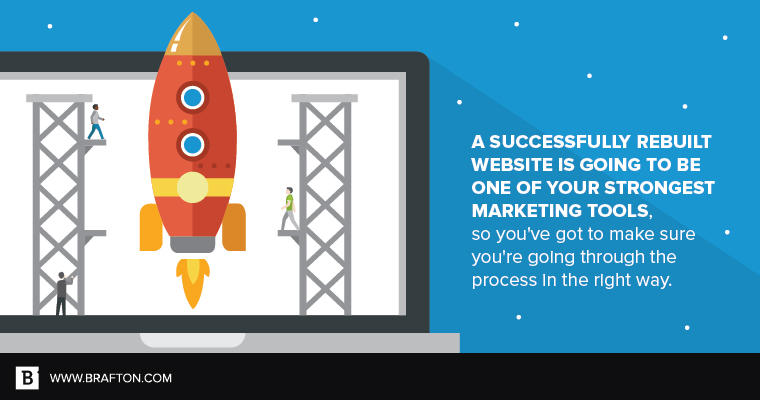You might be one of those insanely talented marketers who can draft up amazing wireframes and mockups, and also use your web development skills to turn them into fantastic websites.
Or you might be like me, someone who still thinks developing websites is a form of magic.
Whichever category you fall into, you know that rebuilding a website takes a lot of work and dedication.
In part one of this series, we talked about the first steps you should take when rebuilding your website: conducting a thorough site evaluation, creating detailed wireframes and mockups, and then meeting with the development team so they can turn your vision into a functioning website.
Now that everything is in the developers’ hands, what comes next? Well, we wanted to get into the mind of a development pro, so I sat down and talked with Brafton’s Director of Technical Services Deryk King to find out what marketers need to know about the development process and what needs to be done after the rebuilt site has been launched.
1. During development
You may have been heavily involved in the first phases of the rebuild, but it’s at this stage that marketers should take a step back, Deryk said.
“Marketers usually have no level of involvement during this time,” he explained. “They should be waiting until the dev team creates a functioning site from the mockups and then brings them a beta version. This usually takes about three to four weeks, depending on the scope of the project. Once the beta version is delivered, marketers can then provide feedback and request changes.”
While you should be patient and let the team focus on development, Deryk warned there are things that could go wrong in the process (I know, that’s not doing any favors for your stress levels).
One of the biggest issues Deryk sees is expectations not being met. What a marketer imagined might not come out the same in development, and this can lead to disappointment. This is why it’s crucial the design and developer teams go over wireframes and mockups in extensive detail during the handover process.
Another problem marketers may run into during development is website malfunctions on different devices or browsers. The best way to avoid this, Deryk suggested, is to know your audience.
“Do your research on which devices and browsers your users are on,” he said. “Include this in your initial planning stages, and make the developers aware.”
Deryk has one motto he says marketers should adopt when rebuilding a website, and especially during the development phase:
“Hope for the best, but plan for the worst. Anything could go wrong, and you need to be prepared for that. If the beta version didn’t come out as expected, communicate with the dev team to get the site where you want it to go.”
2. Pre-launch process
Once the developers have finished their work, there are still a few things you need to do before you launch the new site.
You will need to review the entire site and test the functionality of all features, such as the navigation menu, links, calls to action, forms, sidebars, and everything else. Just like with the evaluation process, make sure you are incredibly thorough. This will give you a chance to fix any issues that would have otherwise appeared on the live site.
Deryk explained there are technical aspects of pre-launch as well. The server configuration needs to be handled, and the DNS credentials need to be passed over. You can work closely with the development team to ensure these factors are addressed before launching.

3. Ready for launch … but when?
In marketing, timing is everything. You’ve probably done a lot of research about the best times to post blog articles, social media updates and other content, and you have it down to a science.
Well, there’s also a best time to launch your rebuilt website.
It’s when you have the least amount of traffic. This way, you don’t risk users coming across problems, and you have time to iron out any last-minute issues that arise. Deryk said that Brafton helps clients launch their sites on either a Friday night or Monday early morning, but each company is different in terms of low traffic times.
“If you’ve done your due diligence during the evaluation, mockup and development stages, then any problems you run into when the site is launched should be minor,” he explained. “However, you should always expect the unexpected, and be prepared to tackle them when they occur.”
4. Post-launch life
Now your website is back up and running, and you’re just waiting for those leads to start rolling in. But your job is not done.
Once the site is live, you need to go through and test the functionality again, just like you did in the pre-launch phase. Check to see that links are working, images and design elements are appearing and that all aspects are rendering as expected.
“To ensure that the live site is fully functioning as it should be, get multiple sets of eyes on it,” Deryk recommended.
Once the site is live, you need to keep checking to ensure everything is updated. For example, Deryk said plugins are an important factor that need to be up to date. There are many other aspects of a site, such as plug-ins, that need continual updates, so make sure you’re addressing those when they need to happen.
5. Lead generation and conversion rate optimization
Now is the time to put all your theories about user experience that result in commercial profits to the test.
Is your audience going to navigate in patterns you anticipated? Are they going to click the calls to action you carefully designed and arranged throughout the site? The answer to these questions is: “You won’t have any idea until you launch and measure.” Simply assuming your site is optimized for lead gen is a mistake.
6. Test, test, then test some more.
All of your CTAs and navigation needs to be evaluated, and continuously re-evaluated, post-launch. Read our post on conversion rate optimization to ensure you are doing everything within your power to create commercial value.
Your hard work has paid off – you’ve successfully rebuilt your website, and you’ve equipped yourself with a successful marketing tool that will give prospects that great first impression of your brand.





